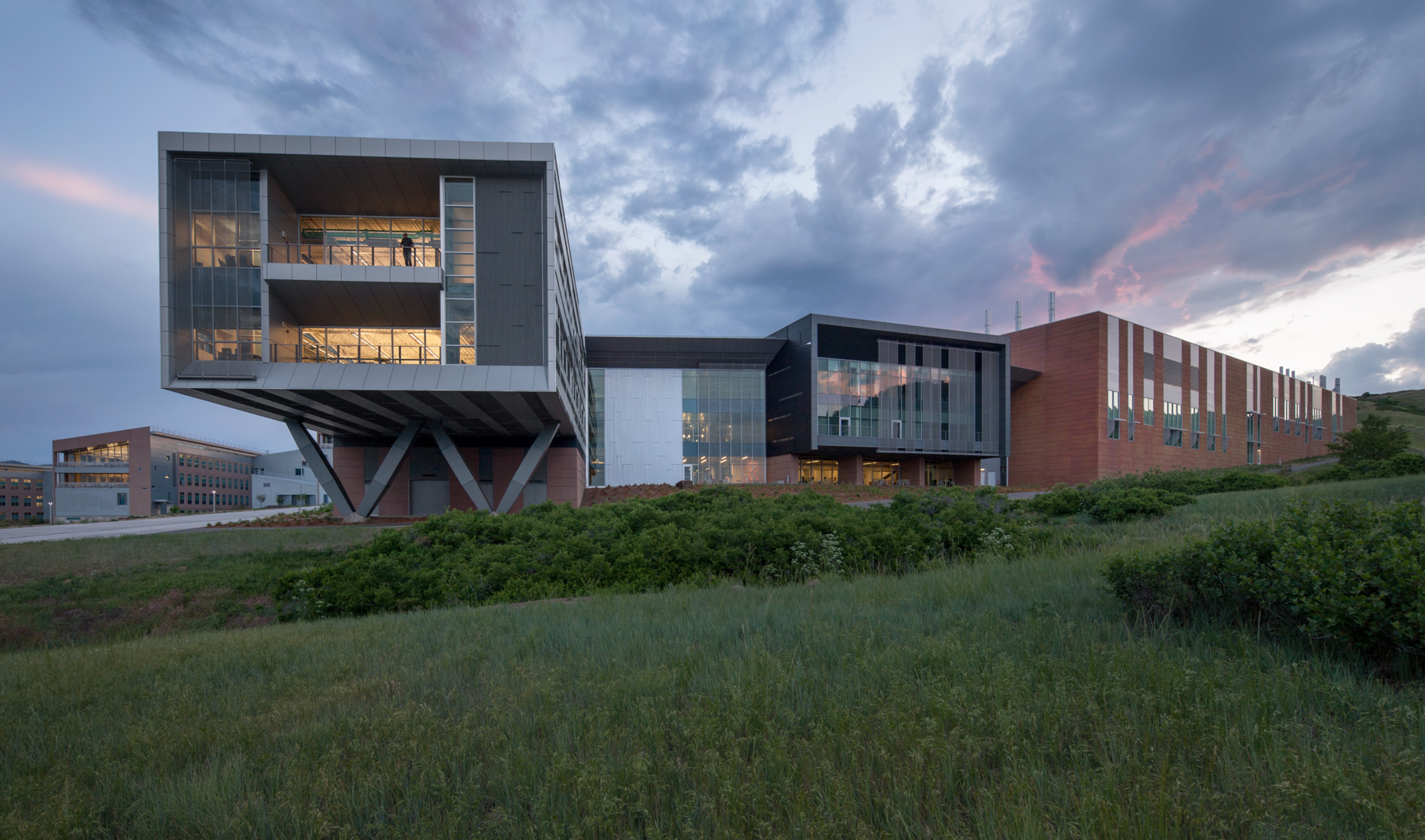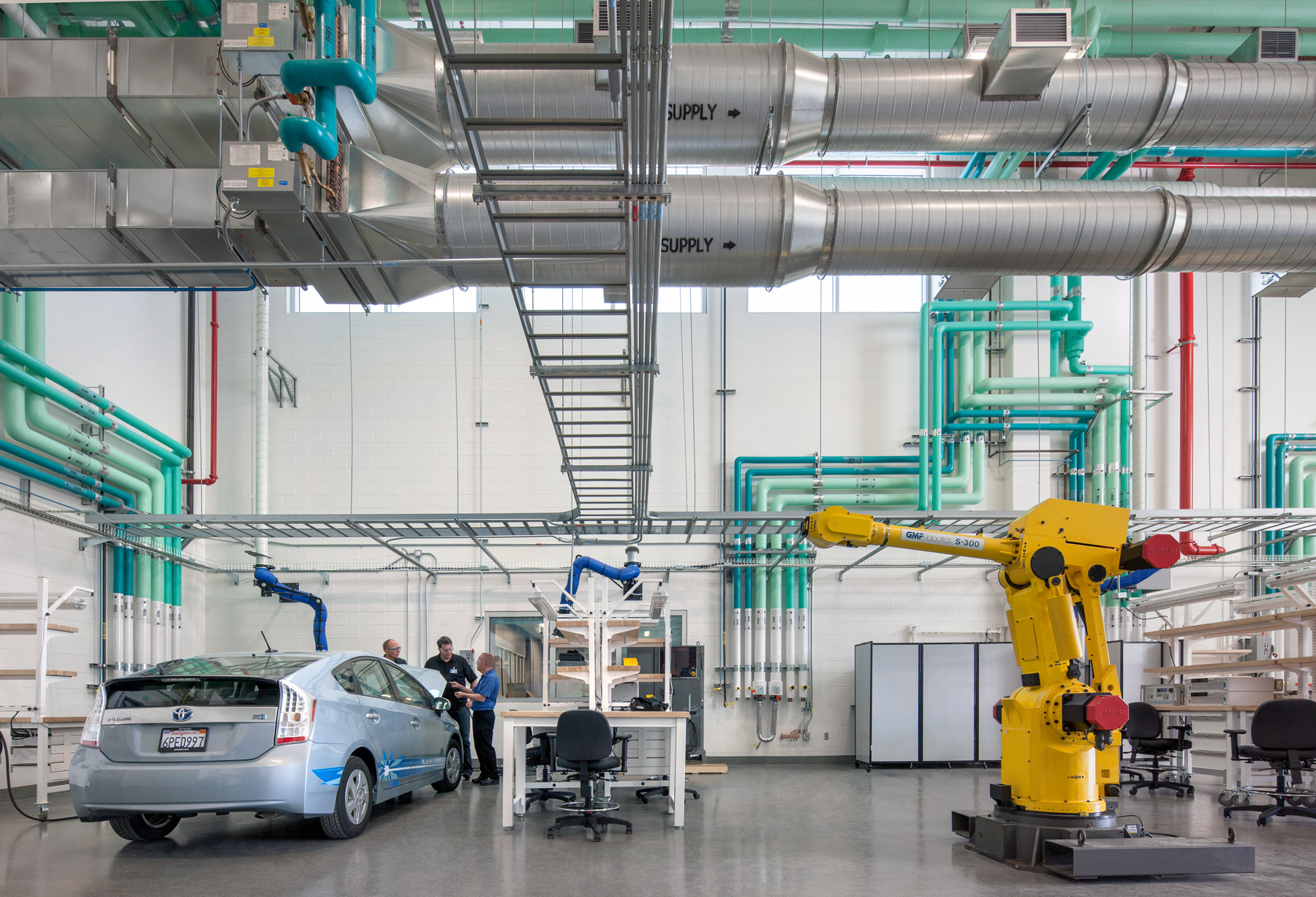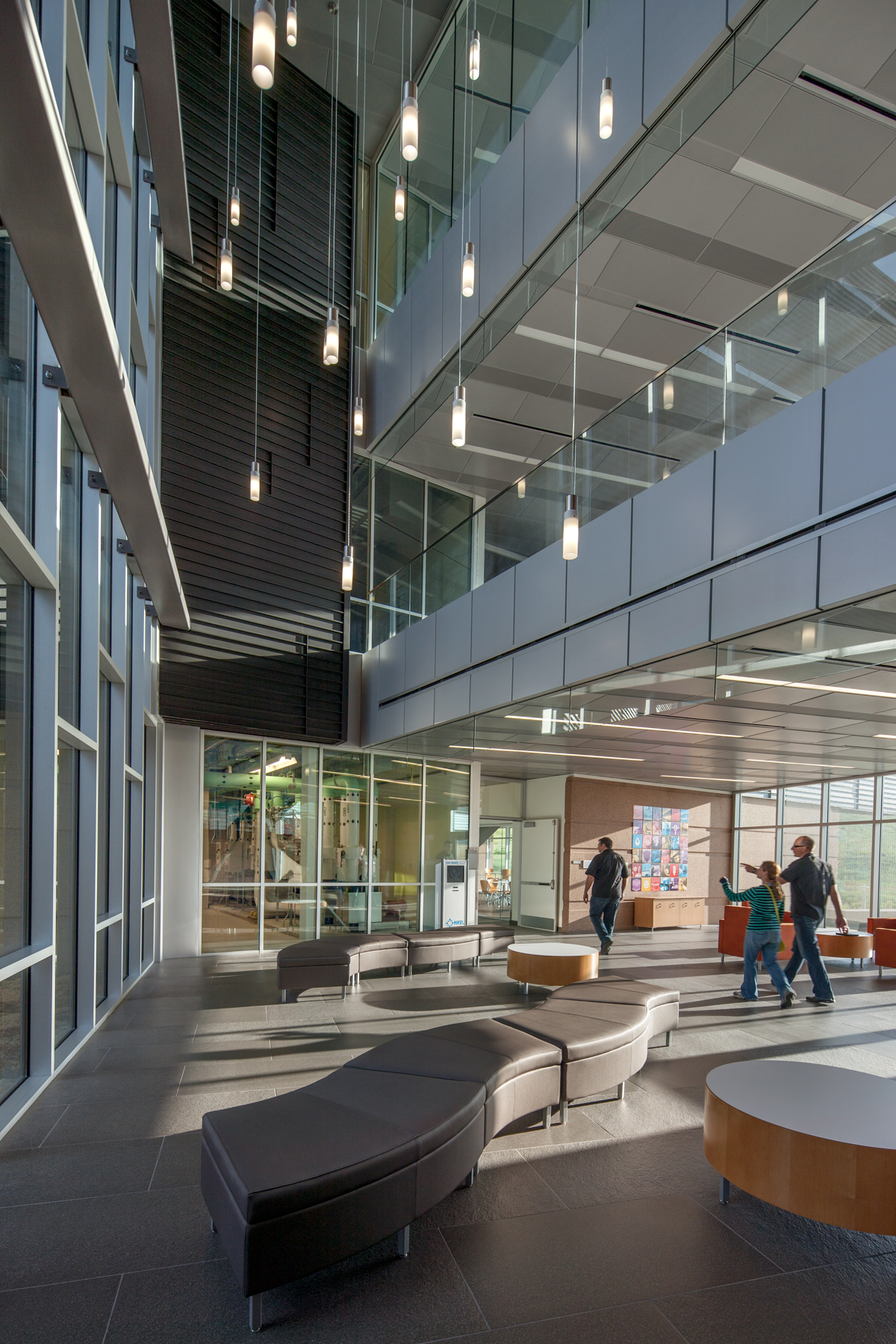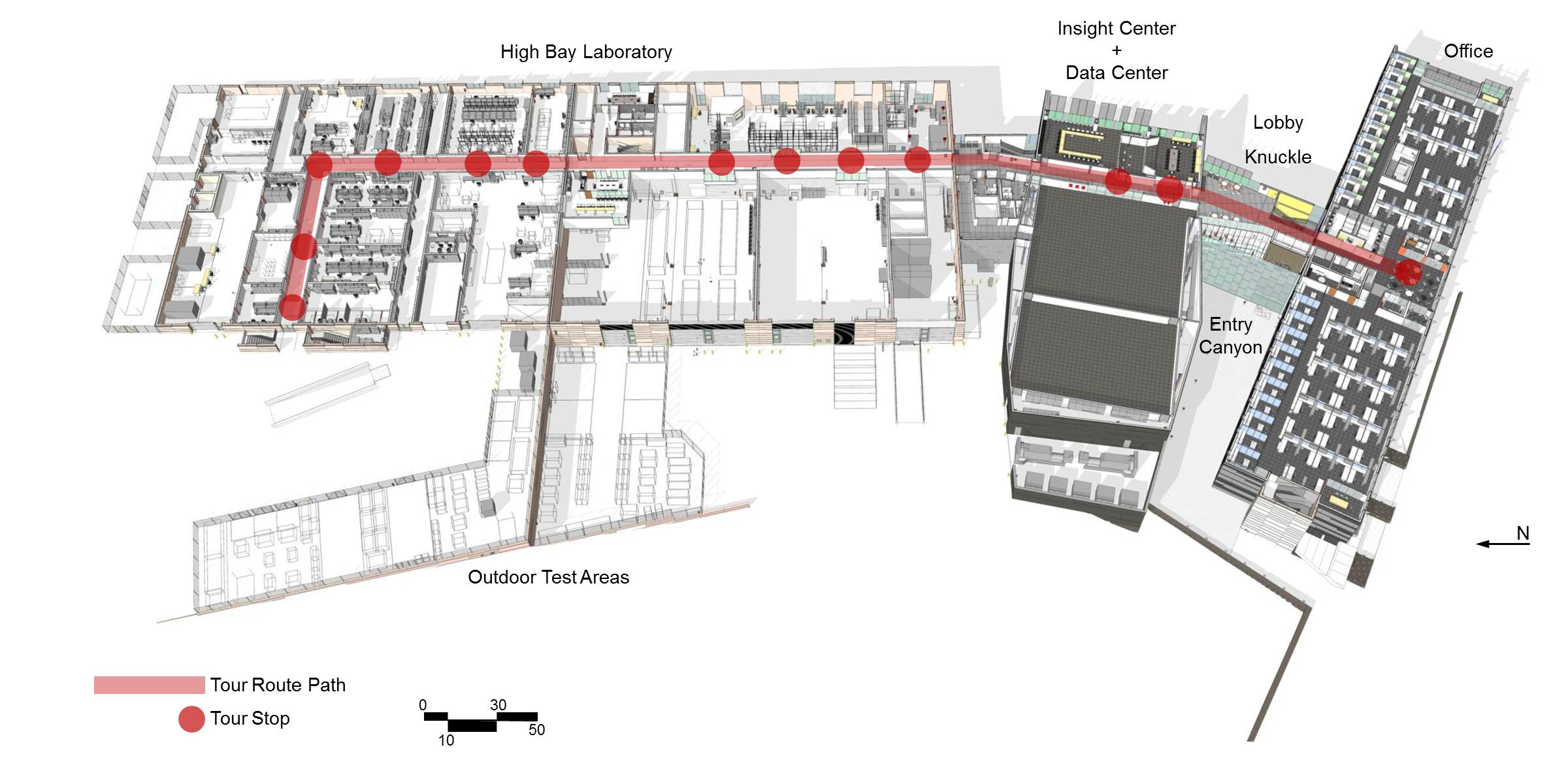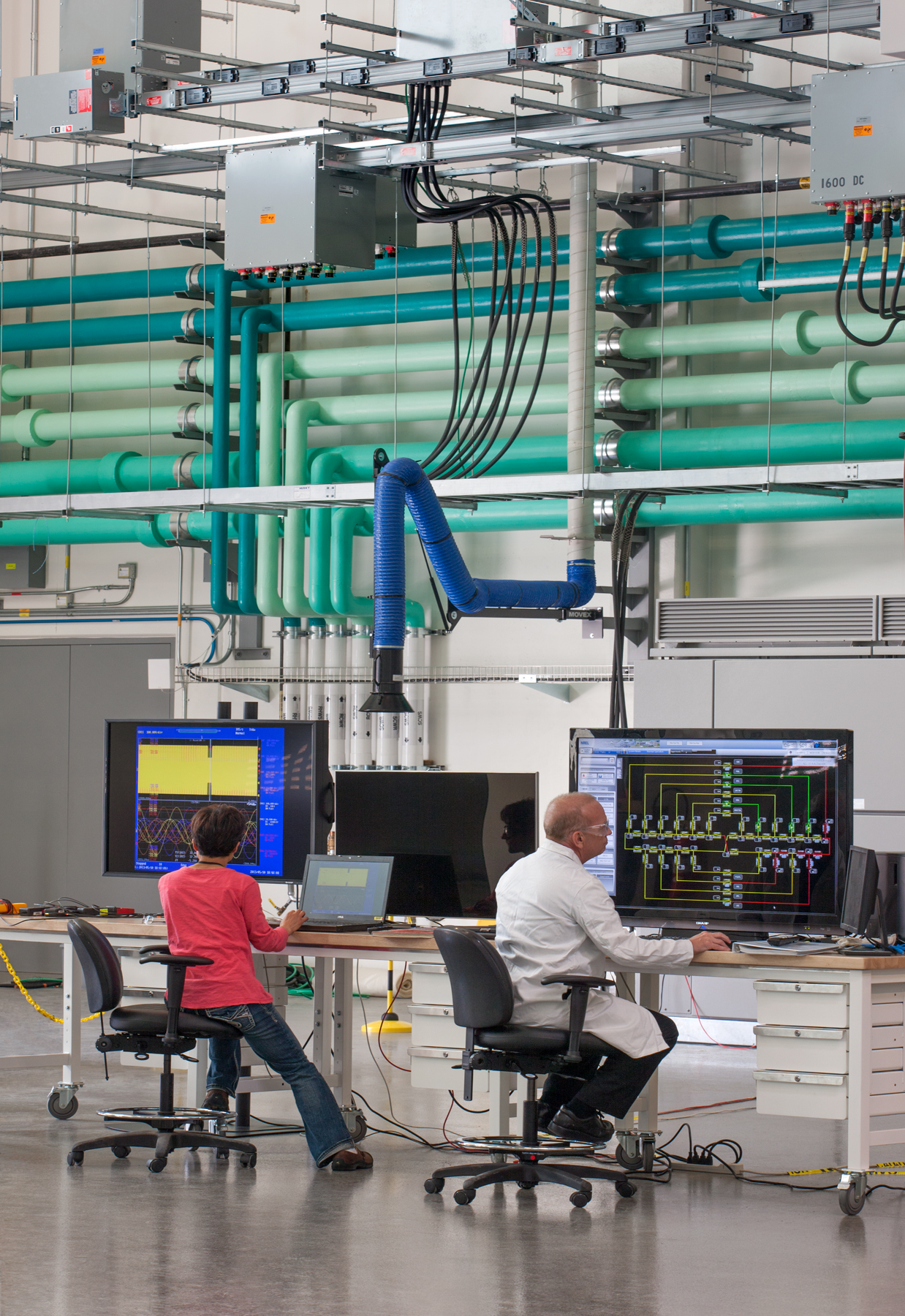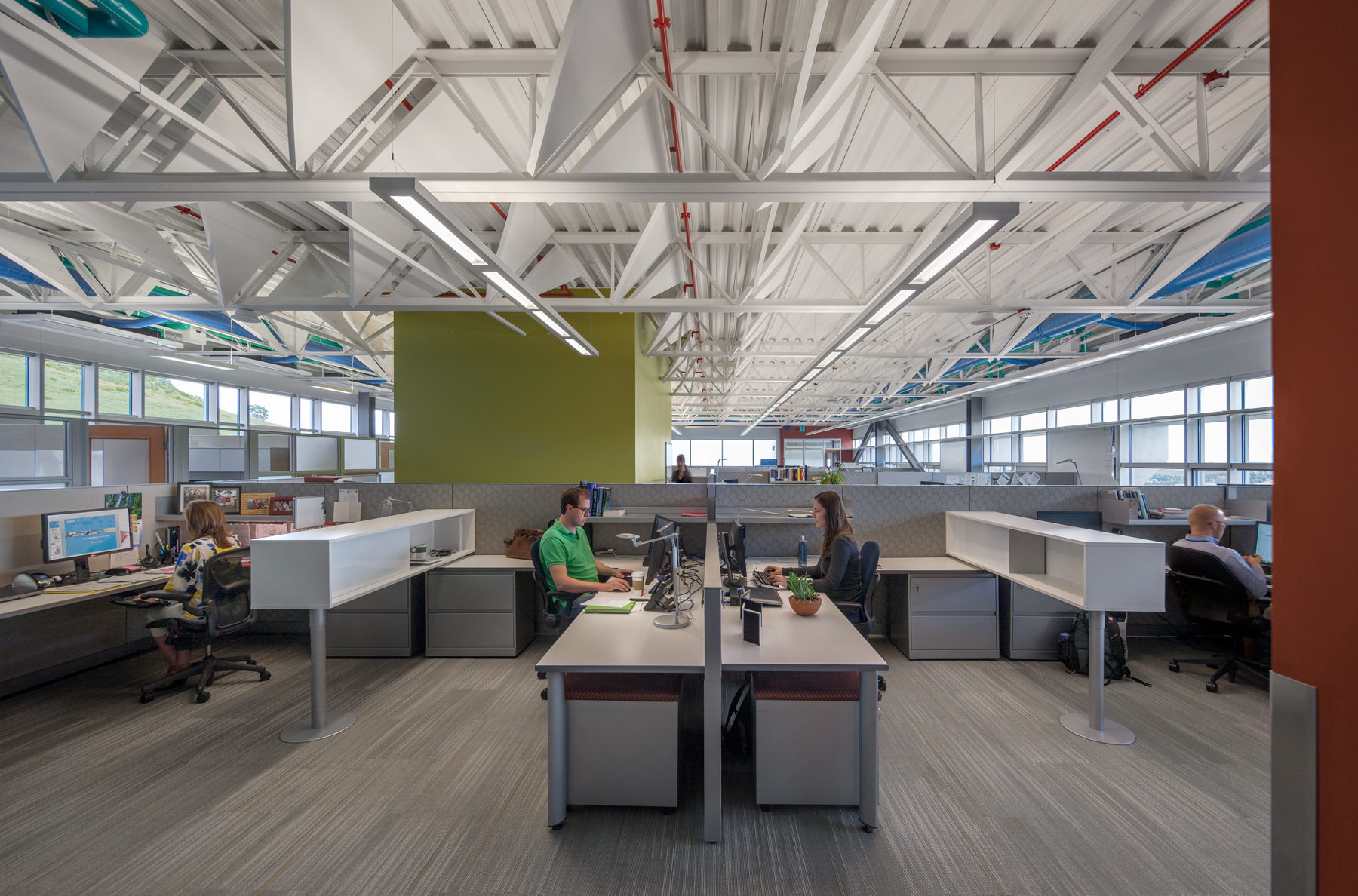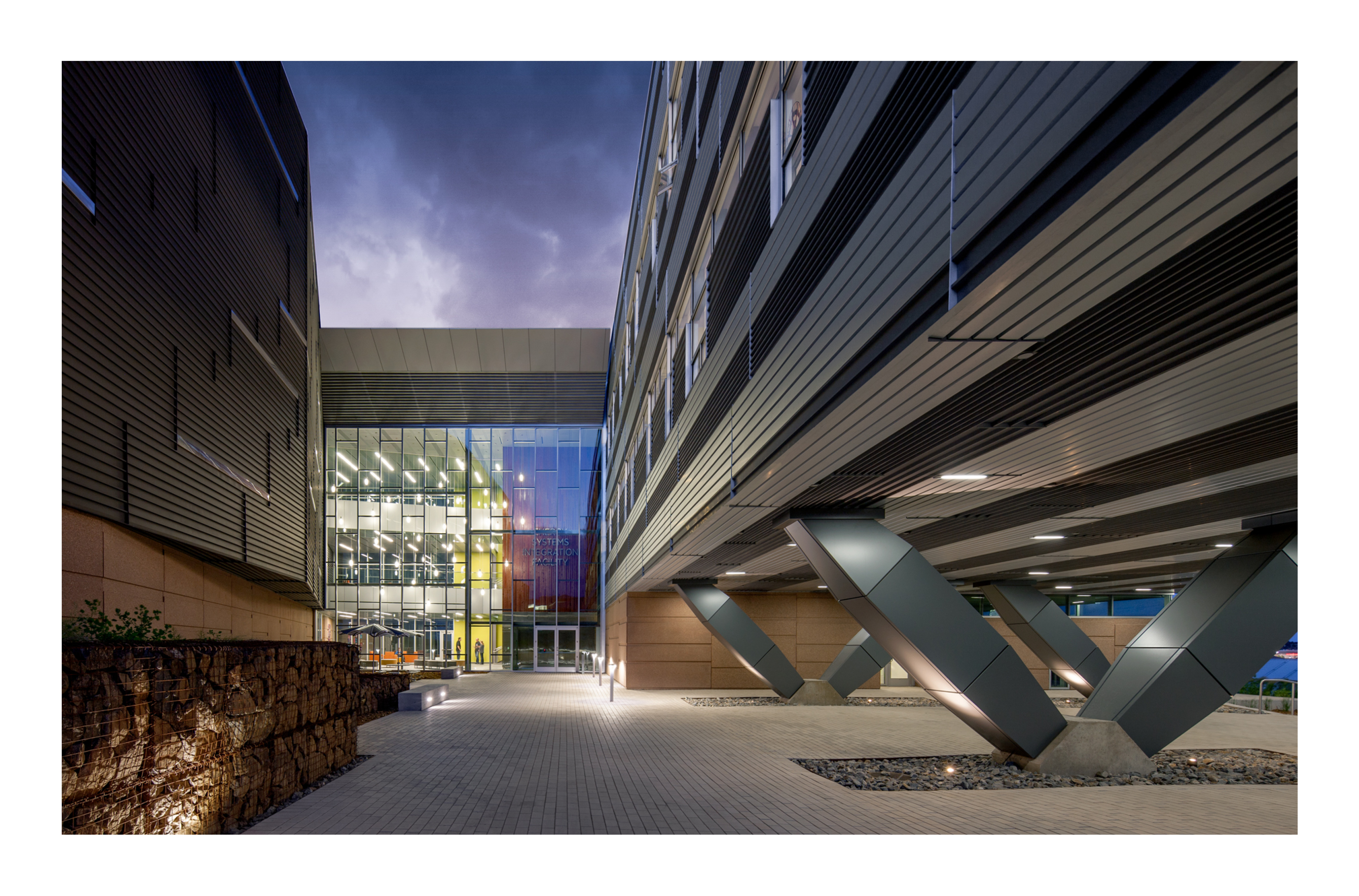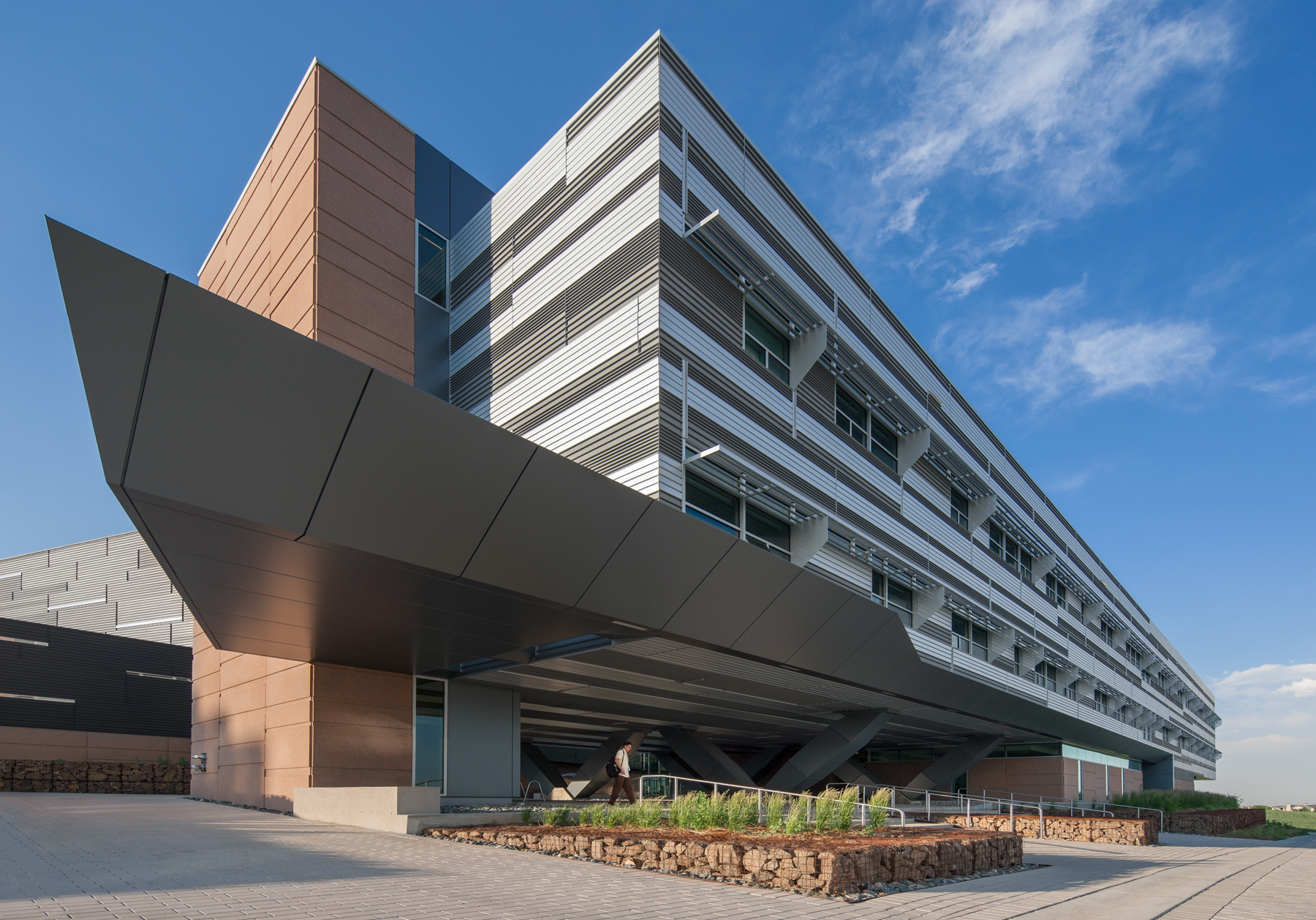One of the nation’s newest and most premier energy research facilities has been named R&D Magazine’s 2014 Laboratory of the Year.
Designed and built by SmithGroupJJR and JE Dunn Construction, the $135 million Energy Systems Integration Facility (ESIF) is located at the U.S. Department of Energy’s National Renewable Energy Laboratory in Golden, Colorado. Its one-of-a-kind design will assist NREL, and its partners, to shape the energy systems of the future.
The prestigious and international Lab of the Year competition, which is in its 48th year, recognizes the best new and renovated laboratories that combine all aspects of the building into a superior working environment. It showcases new and emerging thinking, sustainable practices and creative responses to challenges in the design, construction and operation of modern laboratories.
ESIF received this significant award for being a first-of-its-kind 182,500 sf research user facility with a unique merging of three very specialized components: an ultra-energy efficient workplace that consumes 74% less energy than the national average for office buildings, one of the world’s most energy efficient high performance computing data centers, and sophisticated high-bay laboratory spaces with outdoor test areas.
All of the labs are connected by a research electrical distribution bus (REDB), which functions as a power integration circuit capable of connecting multiple sources of energy with experiments.
The unique design of the facility, which houses 200 researchers, works in tandem to advance NREL’s sustainable mission of integrating clean and sustainable energy technologies into the grid.
“To have the ESIF facility, which advances research capabilities that don’t exist anywhere else in the world, recognized for such a prestigious award only proves the hard work and dedication of the project team,“ states Brad Woodman, AIA, LEED AP BD+C, vice president and director of SmithGroupJJR’s Phoenix office. “Congratulations to the entire ESIF team for a job well done on a project that will change the future of energy thought and use worldwide.”
Responsive Design
A showcase of sustainable design, the ESIF incorporates the best in energy efficiency, environmental performance, and advanced controls using a “whole building” integrated design approach that complies with Energy Star standards.
SmithGroupJJR and JE Dunn worked together to support the Department of Energy’s goal to develop an energy efficient building that imparts minimal impact on the environment. The ESIF earned a LEED Platinum rating from the U.S. Green Building Council, and is one of the highest certified facilities of its type to include a high performance computing data center as a major building component.
To construct such a unique facility the design-build team applied technology, like real time electronic drawings accessible through portable kiosks and hand held tablets allowing for a 100% paperless process, to deliver the project in a highly collaborative and accelerated pace while maintaining the strictest standards of quality and sustainable strategies. The building was dedicated in September 2013.
“Our team was continually challenged and encouraged to think outside the box which lead to this tremendous outcome,” shares Rodd Merchant, senior vice president at JE Dunn Construction and manager of the design-build team. “This award serves as an acknowledgement that hard work pays off.”
Unique Capabilities
Central to the laboratories is the REDB, the nation’s first integrated, megawatt-scale hardware-in-the-loop real-time simulation system. The REDB allows researchers and manufacturers to conduct integration tests at full power and actual load levels in real-time simulation, and evaluate component and system performance before going to market.
Running parallel with the REDB is the Supervisory Control and Data Acquisition (SCADA) system that monitors and controls facility-based processes and gathers and disseminates real time data for collaboration and visualization. Both systems were engineered by Affiliated Engineers, Inc. (AEI).
A petascale high performance computing data and visualization center extends the ESIF’s research capabilities and enables large-scale modeling and simulation of material properties, processes, and fully integrated systems that would be cost-prohibitive to study by direct experimentation.
SmithGroupJJR, a recognized leader in architecture, engineering, and planning, served as designer, lab planner and engineer of the three-story research complex. The firm also received a Lab of the Year Special Mention in 2008 for their work on NREL’s Science & Technology Facility. JE Dunn Construction performed as general contractor for the design-build venture. AEI engineered the high bay laboratory spaces and the REDB and SCADA systems.
Judging for this year’s competition was performed by an expert panel of architects, engineers, equipment suppliers, researchers and the editors of R&D Magazine, Laboratory Design newsletter, and co-sponsor Scientific Equipment and Furniture Association (SEFA).
Awards for the Laboratory of the Year competition will be presented at the 2014 Laboratory Design Conference on April 3, at the Westin Waltham Boston Hotel in Massachusetts.
About the Team
SmithGroupJJR (www.smithgroupjjr.com) is ranked as one of the nation’s top design firms by Architect, the magazine of the American Institute of Architects. The firm’s nationally recognized Science & Technology Practice has completed the planning and design of over 18 million square feet of academic, corporate and government research laboratories across the U.S., ranging from small laboratory renovations to large research campuses. A national leader in sustainable design, SmithGroupJJR has 351 LEED professionals and 102 LEED certified projects.
JE Dunn Construction (www.jedunn.com) maintains local offices in Denver and Colorado Springs, providing quality construction throughout the Rocky Mountains. JE Dunn Construction Company is the 12th largest domestic building contractor in the United States with 20 offices in 14 states. With more than 61 LEED professionals in Colorado and more than 100 LEED certified projects around the country, JE Dunn is a nationally ranked sustainable contractor.
Affiliated Engineers, Inc. (www.aeieng.com) is a multi-disciplinary consulting engineering firm specializing in technically complex projects nationally and internationally in the research, healthcare, energy and utilities, industrial, and sustainability markets. Building Design + Construction magazine’s #1 Science & Technology Engineering Firm, AEI has received five R&D Magazine Laboratory of the Year Awards, including three of the last four and eight other LOY honors. With 157 LEED-certified professionals in twelve offices, AEI has designed and engineered 147 LEED-accredited projects.
Related Stories
| Feb 11, 2011
RS Means Cost Comparison Chart: Office Buildings
This month's RS Means Cost Comparison Chart focuses on office building construction.
| Feb 11, 2011
Sustainable features on the bill for dual-building performing arts center at Soka University of America
The $73 million Soka University of America’s new performing arts center and academic complex recently opened on the school’s Aliso Viejo, Calif., campus. McCarthy Building Companies and Zimmer Gunsul Frasca Architects collaborated on the two-building project. One is a three-story, 47,836-sf facility with a grand reception lobby, a 1,200-seat auditorium, and supports spaces. The other is a four-story, 48,974-sf facility with 11 classrooms, 29 faculty offices, a 150-seat black box theater, rehearsal/dance studio, and support spaces. The project, which has a green roof, solar panels, operable windows, and sun-shading devices, is going for LEED Silver.
| Feb 11, 2011
BIM-enabled Texas church complex can broadcast services in high-def
After two years of design and construction, members of the Gateway Church in Southland, Texas, were able to attend services in their new 4,000-seat facility in late 2010. Located on a 180-acre site, the 205,000-sf complex has six auditoriums, including a massive 200,000-sf Worship Center, complete with catwalks, top-end audio and video system, and high-definition broadcast capabilities. BIM played a significant role in the building’s design and construction. Balfour Beatty Construction and Beck Architecture formed the nucleus of the Building Team.
| Feb 11, 2011
Kentucky’s first green adaptive reuse project earns Platinum
(FER) studio, Inglewood, Calif., converted a 115-year-old former dry goods store in Louisville, Ky., into a 10,175-sf mixed-use commercial building earned LEED Platinum and holds the distinction of being the state’s first adaptive reuse project to earn any LEED rating. The facility, located in the East Market District, houses a gallery, event space, offices, conference space, and a restaurant. Sustainable elements that helped the building reach its top LEED rating include xeriscaping, a green roof, rainwater collection and reuse, 12 geothermal wells, 81 solar panels, a 1,100-gallon ice storage system (off-grid energy efficiency is 68%) and the reuse and recycling of construction materials. Local firm Peters Construction served as GC.
| Feb 11, 2011
Former Richardson Romanesque hotel now houses books, not beds
The Piqua (Ohio) Public Library was once a late 19th-century hotel that sat vacant and deteriorating for years before a $12.3 million adaptive reuse project revitalized the 1891 building. The design team of PSA-Dewberry, MKC Associates, and historic preservation specialist Jeff Wray Associates collaborated on the restoration of the 80,000-sf Richardson Romanesque building, once known as the Fort Piqua Hotel. The team restored a mezzanine above the lobby and repaired historic windows, skylight, massive fireplace, and other historic details. The basement, with its low ceiling and stacked stone walls, was turned into a castle-like children’s center. The Piqua Historical Museum is also located within the building.
| Feb 11, 2011
Justice center on Fall River harbor serves up daylight, sustainable elements, including eucalyptus millwork
Located on historic South Main Street in Fall River, Mass., the Fall River Justice Center opened last fall to serve as the city’s Superior and District Courts building. The $85 million facility was designed by Boston-based Finegold Alexander + Associates Inc., with Dimeo Construction as CM and Arup as MEP. The 154,000-sf courthouse contains nine courtrooms, a law library, and a detention area. Most of the floors have the same ceiling height, which will makes them easier to reconfigure in the future as space needs change. Designed to achieve LEED Silver, the facility’s elliptical design offers abundant natural daylight and views of the harbor. Renewable eucalyptus millwork is one of the sustainable features.
| Feb 11, 2011
Research facility separates but also connects lab spaces
California State University, Northridge, consolidated its graduate and undergraduate biology and mathematics programs into one 90,000-sf research facility. Architect of record Cannon Design worked on the new Chaparral Hall, creating a four-story facility with two distinct spaces that separate research and teaching areas; these are linked by faculty offices to create collaborative spaces. The building houses wet research, teaching, and computational research labs, a 5,000-sf vivarium, classrooms, and administrative offices. A four-story outdoor lobby and plaza and an outdoor staircase provide orientation. A covered walkway links the new facility with the existing science complex. Saiful/Bouquet served as structural engineer, Bard, Rao + Athanas Consulting Engineers served as MEP, and Research Facilities Design was laboratory consultant.
| Feb 11, 2011
A feast of dining options at University of Colorado community center, but hold the buffalo stew
The University of Colorado, Boulder, cooked up something different with its new $84.4 million Center for Community building, whose 900-seat foodservice area consists of 12 micro-restaurants, each with its own food options and décor. Centerbrook Architects of Connecticut collaborated with Denver’s Davis Partnership Architects and foodservice designer Baker Group of Grand Rapids, Mich., on the 323,000-sf facility, which also includes space for a career center, international education, and counseling and psychological services. Exterior walls of rough-hewn, variegated sandstone and a terra cotta roof help the new facility blend with existing campus buildings. Target: LEED Gold.
| Feb 11, 2011
Chicago high-rise mixes condos with classrooms for Art Institute students
The Legacy at Millennium Park is a 72-story, mixed-use complex that rises high above Chicago’s Michigan Avenue. The glass tower, designed by Solomon Cordwell Buenz, is mostly residential, but also includes 41,000 sf of classroom space for the School of the Art Institute of Chicago and another 7,400 sf of retail space. The building’s 355 one-, two-, three-, and four-bedroom condominiums range from 875 sf to 9,300 sf, and there are seven levels of parking. Sky patios on the 15th, 42nd, and 60th floors give owners outdoor access and views of Lake Michigan.
| Feb 11, 2011
Iowa surgery center addresses both inpatient and outpatient care
The 12,000-person community of Carroll, Iowa, has a new $28 million surgery center to provide both inpatient and outpatient care. Minneapolis-based healthcare design firm Horty Elving headed up the four-story, 120,000-sf project for St. Anthony’s Regional Hospital. The center’s layout is based on a circular process flow, and includes four 800-sf operating rooms with poured rubber floors to reduce leg fatigue for surgeons and support staff, two substerile rooms between each pair of operating rooms, and two endoscopy rooms adjacent to the outpatient prep and recovery rooms. Recovery rooms are clustered in groups of four. The large family lounge (left) has expansive windows with views of the countryside, and television monitors that display coded information on patient status so loved ones can follow a patient’s progress.


